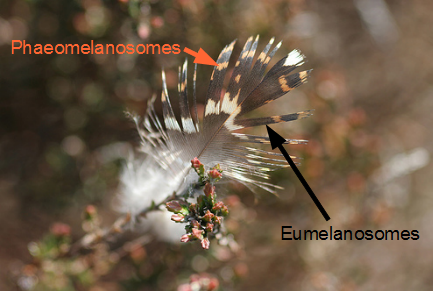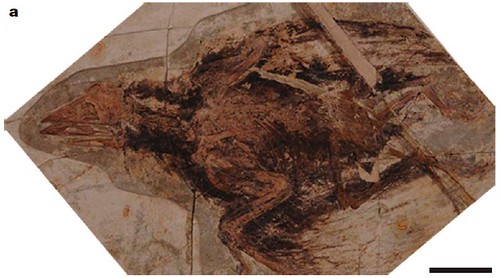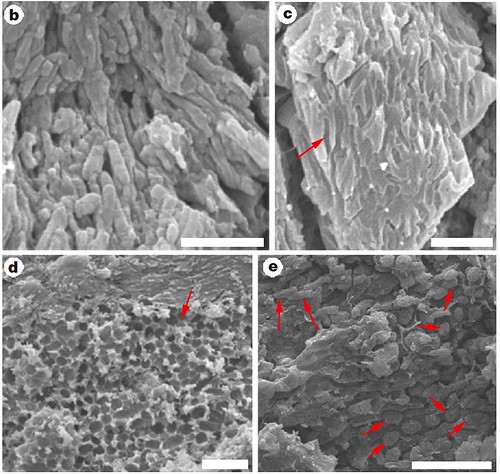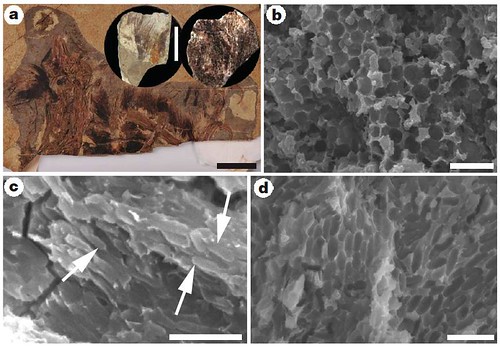tags: evolutionary biology, fossils, feathers, plumage color, color, dinosaurs, theropods, Sinosauropteryx, Sinornithosaurus, birds, Confuciusornis, melanosomes, phaeomelanosomes, eumelanosomes, keratinocytes, SEM, scanning electron microscopy, 10.1038/nature08740, researchblogging.org, peer-reviewed research, peer-reviewed paper
Reconstruction of two Sinosauropteryx, sporting their orange and white striped tails.
Artwork by Chuang Zhao and Lida Xing [larger view]
DOI: 10.1038/nature08740
While looking at museum dioramas that feature dinosaurs, I often overhear people asking "How do they know what color dinosaurs were?" The truth is that artists and scientists didn't know -- until now. A new paper was just published in Nature that carefully examines fossilized plumage and comes to an interesting conclusion: scientists can identify at least some of the original colors in ancient feathers.
Dinosaurs were close evolutionary relatives of both reptiles and birds, and because both reptiles and birds can have striking colors that they use to send visual signals, for camouflage and for display, it is reasonable to predict that at least some dinosaurs also sported bright colors. Color vision is also suggestive: unlike most mammals, both birds and reptiles can see a wide spectrum of colors. So it is reasonable to predict that color vision got its start in dinosaurs, and that dinosaurs used colors to communicate with others.
Based on fossil discoveries of skin impressions from dinosaur fossils, scientists now have a good idea of the texture of dinosaur skin -- and the spectacular new fossils unearthed in the previous few years in northern China reveal that some dinosaurs even had feathers. But nobody can say with certainty what color those dinosaur feathers were, or even if those feathers were colored at all, because fossils don't preserve color.
But fossils may preserve miniscule details, as confirmed by newly published scanning electron microscopy (SEM). These data reveal that the fossil feathers from several Chinese dinosaur finds contain melanosomes -- tiny intracellular structures that produce and store melanins.
"Melanin is what gives color to human hair and animal fur," says paleobiologist Mike Benton from the University of Bristol in the UK, who led the study. "They are also the most common way that colors are [produced] in feathers."
The two most common types of melanin are phaeomelanin (reddish-brown to yellow) and eumelanin (black and greys). Differently shaped melanosomes store different colors, with blacks or greys are produced by "sausage-shaped" melanosomes, while reds or oranges are found in spherical ones.
Undoctored image courtesy of Richard Carter. Doctoring done by Dr Bob O'Hara.
"A ginger-haired person would have more spherical melanosomes, and a black-haired or grey-haired person would have more of the sausage-shaped structures," explains Dr Benton.
But melanosomes resemble bacteria in both size and shape, so it was critical to distinguish between the two possibilities. The team used three pieces of evidence to confirm that the microstructures in the fossilized Chinese dinosaurs actually are melanosomes.
The team compared SEM images that they got of an isolated feather fossil (Figure 1), to those they got of fossilized feathers from the ancient bird, Confuciusornis (Figure 2), and to the integumentary filament fossils from the theropod dinosaurs Sinosauropteryx (Figure 3) and Sinornithosaurus (Figure 4).
Figure 1 | Melanosomes in an isolated pennaceous feather (IVPP V15388B). a, Optical photograph; position of area analysed by SEM indicated by arrow. b, c, SEM images (at lower and higher magnification, respectively) of eumelanosomes preserved as moulds inside small areas that are separated from each other by anastomosing ridges of degraded feather (at arrows in c). Scale bars: a, 5 mm; b, 20 μm; c, 5 μm. [larger view]
DOI: 10.1038/nature08740
First, the team found that some parts of a fossil feather lack melanosomes (specifically, the calamus and proximal part of the rachis) -- and melanosomes are likewise absent from these same structures in the Chinese fossils.
Second, the team found that melanosomes do not coat the feather surface (as bacteria would do), but instead, they are embedded inside the feathers (for example, Figure 2, c, d & e).
Figure 2 | Melanosomes in feathers of the bird Confuciusornis (IVPP V13171). a, Optical photograph. b, Strongly aligned, closely spaced, eumelanosomes preserved as solid bodies. c, Mouldic (that is, preserved as moulds) eumelanosomes (at arrow) a short distance above a layer in which the eumelanosomes are preserved as aligned solid bodies. d, Area (at arrow) comprising more widely spaced mouldic phaeomelanosomes surrounded by less distinct, aligned eumelanosomes (top of image). e, Gradational boundary between areas dominated by eumelanosomes (longer arrows) and phaeomelanosomes (shorter arrows), both preserved as solid bodies. Scale bars: a, 50 mm; b-e, 2 μm. [larger view: a, b, c, d, e]
DOI: 10.1038/nature08740
Third, "sausage-shaped" eumelanosomes occur only in the dark bands of banded feathers, but not in light bands, suggesting a red-and-white pattern of stripes. If these structures were fossilized bacteria, they would most likely occur as a uniformly preserved field of round blobs and/or sausages, and not stop suddenly along what appears to be a feather stripe.
Figure 3 | Melanosomes in the integumentary filaments of the dinosaur Sinosauropteryx (IVPP V14202). a, Optical photograph of the proximal part of the tail. Arrow indicates position of sample removed previously. b, Optical photograph of sample of integumentary filaments; position of SEM sample (inset) indicated by arrow. c, Mouldic phaeomelanosomes within a filament. Scale bars: a, 50 mm; b, main panel, 20 mm, and inset, 1 mm; c, 2 μm. [larger view]
DOI: 10.1038/nature08740
Not only do these data indicate that dinosaur feathers were colored, but they also suggest likely colors and patterns for those colors. Individual Confuciusornis feathers contain variable amounts of phaeomelanosomes and eumelanosomes over short distances (Figure 2e), indicating that they probably had rich colors and patterns that have yet to be fully appreciated.
In contrast, the filaments of the theropod Sinornithosaurus (Figure 3) are packed with regions that are rich in either eumelanosomes or phaeomelanosomes, indicating that they might have been speckled with the distinctive Hallowe'en motif; orange and black.
Even Sinosauropteryx (Figure 4) -- the oldest feathered dinosaur yet unearthed -- has melanosomes in its filaments: both the tail and back filaments contain dark-colored phaeomelanosomes, suggesting a rich chestnut color.
"There's a very clear rim of feathers running down the top of its head like a Mohican, all the way along its back," describes Dr Benton (refer to image at top).
Figure 4 | Melanosomes in the integumentary filaments of the dinosaur Sinornithosaurus (IVPP V12811). a, Optical photographs of part of the holotype and SEM samples (insets). b, Mouldic phaeomelanosomes. c, Aligned eumelanosomes preserved as solid bodies (at arrows). d, Strongly aligned mouldic eumelanosomes. Scale bars: a, main panel, 50 mm and inset, 5 mm; b-d, 2 μm. [larger view]
DOI: 10.1038/nature08740
This body of evidence suggest that these microscopic internal structures are melanosomes instead of fossilized bacteria.
"This is the first time anyone has ever had evidence of original color of feathers in dinosaurs," explains Dr Benton.
This work also supports the hypothesis that the filaments on the theropod dinosaurs Sinosauropteryx and Sinornithosaurus are probably the evolutionary precursors of true feathers. So these findings could help resolve a long-standing debate about the evolution and original function of feathers.
"We now know that feathers did not originate as flight structures," explains Dr Benton. This suggests that they evolved, initially, for insulation and perhaps for display.
These findings add yet more support to the large body of data showing that birds evolved from theropod (flesh-eating) dinosaurs. It also demonstrates that the special characters that define modern bird -- feathers, wings, lightweight skeleton, and visual capabilities, just to name a few -- evolved step-by-step over some 50 million years of dinosaur evolution. These findings also provide scientists with a valuable tool for exploring the behavior of dinosaurs and early birds.
"These discoveries open up a whole new area of research, allowing us to explore aspects of the life and behavior of dinosaurs and early birds that lived over 100 million years ago," marvels Dr Benton.
These data show that early feathers probably did not originally appear for the purpose of flight or thermoregulation.
"Furthermore, we now know that the simplest feathers in dinosaurs such as Sinosauropteryx were only present over limited parts of its body -- for example, as a crest down the midline of the back and round the tail -- and so they would have had only a limited function in thermoregulation," he explains.
"Feathers are key to the success of birds and we can now dissect their evolutionary history in detail and see how each feather type -- and the fine detail of feather structure -- was acquired through time," Dr Benton predicts. "This will link with current work on how the genome controls feather development."
Jakob Vinther, a grad student at Yale University who originally inspired Dr Benton's work with his own pioneering study of melanins in fossil bird feathers, remains cautious, saying that the study did not provide enough detail to give a full-blown picture of a dinosaur's color patterns. "One or two samples is not going to do it," he adds.
Source:
Zhang, F., Kearns, S., Orr, P., Benton, M., Zhou, Z., Johnson, D., Xu, X., & Wang, X. (2010). Fossilized melanosomes and the colour of Cretaceous dinosaurs and birds. Nature DOI: 10.1038/nature08740








First dinos were dumb ectothermic poikilotherms. Then they were dumb ectothermic homeotherms. Then they were smart endothermic homeotherms, with feathers for insulation. Now they're smart endothermic homeotherms with feathers for insulation, gliding, powered flight and sexually selected pigmentation patterns for lekking display. How rapidly dinos have evolved in the past 50 years!
That really is fascinating. And it makes perfect intuitive sense. I am constantly amazed at the skill these researchers show in teasing out information out of such tiny clues.
What a weird post-modernist view of the world. Dinosaurs haven't changed much in the past 50 years. What has changed is our understanding of them.
Indeed. There are several highly-trained squads of dinorevisionists who descend, almost nightly, on the museums and evacuations around the world to adjust the fossils and toss yesterday's knowledge into the memory hole. Big Dino is watching, and the Palaeontologic Police are expert at re-educating anyone who spouts what is now untrue.
It's our understanding of dinos that's changed in the past 50 years, llewelly, and not the beasts themselves!?!
Say it isn't so! :P
It's really impressive work, for which I congratulate the authors, but let me quibble with a few details in the press release and your post:
No, it's reasonable to assume that the dinosaurs (birds are after all dinosaurs) have simply retained the ancestral state of color vision, which is seen in almost all vertebrates other than placental mammals.
No, it has the exact same age as Confuciusornis and Sinornithosaurus. It is the feathered dinosaur that is the least closely related to the birds, which makes it even more interesting here than if it were merely the oldest one.
That's likely an artefact of preservation and of not looking at the fossils carefully enough.
Philip J. Currie & Chen Peiji (2001): Anatomy of Sinosauropteryx prima from Liaoning, northeastern China, Canadian Journal of Earth Sciences | Revue canadienne des sciences de la Terre 38(12): 1705 â 1727
From what I know about Benton, he didn't have time to read this paper. :-)
And I completely forgot to complain about the artwork! :-) From an artistic point of view, it's great, but... that's not the tail that's bent upwards here. It's the sacrum and pelvis that is broken in the middle. And the thumb claw is way too small.
The paper I cited can apparently be accessed for free by all Canadians.
My quibble on the art- Sinosauropteryx (I love that guy!) had a very long tail. Them tails don't seem long enough. Two: I second MarjanoviÄ in thinking the S. prima fossil looked like it only preserved feathers in silhouette, as if it probably had them all over its body and only kept a cross-section in the fossil. I'd like to know how we're wrong, if we are.
I noticed the banding of color on S. prima's tail the second I saw it, and am always amazed by some paleoartists getting it wrong (lateral tail stripes? spots?). In fact, I think S. prima had at least light belly feathers that haven't been noticed because they were pigmentless. The pattern of visible (darker) feathers on S. prima's fossil matches the pattern of terrestrial vertebrates of today so well - dark on top, light on bottom, striped tail. It's a beauty.
"So these findings could help resolve a long-standing debate about the evolution and original function of feathers." I severely doubt it. "These data show that early feathers probably did not originally appear for the purpose of ... thermoregulation." I seriously doubt it. As I see it, the S. Prima's colors are like http://www.animalpicturesarchive.com/ArchOLD-1/1100658411.jpg or a less dramatic version of http://www.rspb.org.uk/Images/pheasant_female_300_tcm9-153225.jpg , which I don't see as an important tool of sexual selection so much as reasonable colors for a small predator. The debate continues...
Orange is the best color ever.